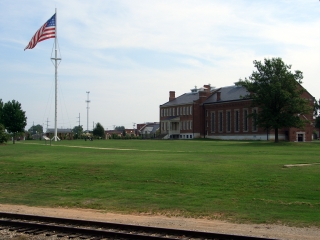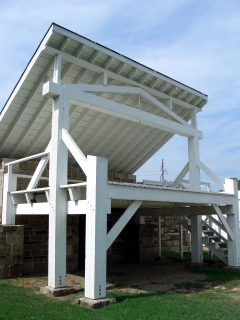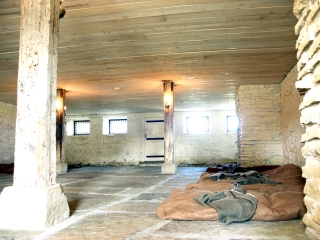NPS Website; Local Website
WHAT IS IT?
Place where for much of the late 19th Century Judge Isaac Parker, the famed “Hanging Judge”, presided over the Federal Court of the Western District of Arkansas. Fort Smith marked the tenuous boundary between the United States and the then Indian Territory, now known as Oklahoma.
 BEAUTY (2/10)
BEAUTY (2/10)Fort Smith looks very official with it two story red-brick stare, vertical jailhouse windows, wide girth and imposing 37-star American flag. Few would argue that the building is beautiful. Its restored first-floor jail cells once held the moniker, “Hell on the Border”. Things have not changed much.
Next door stands a reproduction of the 1886 gallows where 79 men saw their doom. The short walk to the Arkansas River overlook does not improve the situation. The wide, slow moving mucky River emanates humidity while exhibit panels discuss the dark days of the Trail of Tears.
HISTORICAL INTEREST (5/10)
When the U.S. built the first Fort Smith in 1817, this area must have felt like the edge of the earth. Its original purpose was to keep the peace between the native Osage Indians and the forced émigrés of the Cherokee Nation. Either no one thought the two completely different nations of Indians would not appreciate living in the same area or no one cared.
The U.S. Government’s forced removal policy of southeastern Indians continued in earnest under Pres. Andrew Jackson with the passage of the 1830 Indian Removal Act. The westward march to Indian Territory (now Oklahoma) of the Chickasaw, Choctaws, Creeks, Seminoles and Cherokees caused mass death and became known as the Trail of Tears.
Indian Territory stood just across the river from Fort Smith and the Fort’s role would always be defined by its proximity. A second Fort Smith began construction in the 1840’s as protection for Arkansas settlers against the Indian Territory’s real and imagined threats. The practical need for such a Fort was never realized so the building became a supply depot for the frontier.
In 1871, the Federal Court moved into the abandoned depot, the supply lines for the Indian Wars needed to be further west. This Federal Court’s jurisdiction was virtually lawless Indian Territory, its arbiter from 1875-1896 was Isaac Parker, the Hanging Judge, his exploits retold in the Clint Eastwood western, Hang ‘Em High.
Legendary old west stories abound at Fort Smith NHS. They have found their way into books , oral history and additional films, like True Grit, Lonesome Dove and Belle Starr, The Bandit Queen.
CROWDS (6/10)
Most people in Arkansas are in church on Sunday morning. Not us, we were learning about the Trail of Tears and a gleeful Executioner. Boisterous singing emanated from all around as we wandered the Fort’s grounds. Could there be a church on Site? Almost. A makeshift service had sprouted just north of the park’s border taking place underneath the Arkansas River Bridge.
 EASE OF USE/ACCESS (4/5)
EASE OF USE/ACCESS (4/5)Fort Smith NHS is located along the eastern bank of Arkansas River in downtown Fort Smith. If you are coming from Oklahoma, take I-40, Exit 325. Go east on U.S. Route 64 towards the Arkansas border for about six miles. Once you cross Arkansas River Bridge take the third right onto 4th Street. Turn right at Garland and into the large parking lot. Fort Smith is right there.
There are a number of ways to approach downtown Fort Smith from the east, none of them demonstratively better to the non-native eye. We took I-40, Exit 7 to I-540. We took I-540 south for eight miles until Exit 8. We got onto Arkansas 22 a/k/a Rogers Avenue and took it straight downtown, about three miles. Traffic was stop and go along a commercial street. None of the alternate routes downtown looks easier.
CONCESSIONS/BOOKSTORE (5/5)
Three biographies of the Isaac Parker, vast sections about Westward Expansion, the Six Indian Nations that marched the Trail of Tears, local Arkansas history and Military History. The selection does not stop with books, posters and maps. There are outlaw and lawman playing cards, painted ceramic tiles, blown glass vases and reprinted Harper’s Weekly articles about the Fort. The store is stocked with neat, thought-provoking knick-knacks.
COSTS (2/5)
Entry is $4 per person or $8 per person. The admission fee is waived if you own the National Parks Pass.
RANGER/GUIDE TO TOURIST RATIO (5/5)
A sampling of the questions we volleyed at two knowledgeable Rangers: So, is this place haunted? The cleaning service sure thinks so. Which part of "Lonesome Dove" took place here? It’s been a while since I watched it but I think it happened near the beginning. How many people lived in Indian Territory during Judge Parker’s reign? That’s a good question. Census takers never went into the region. Sounds like a Master’s thesis to me. So how come so many criminals became deputy marshals and vice versa? They were probably just trying to make a living. Was their widespread violence in Indian Country or was word of killings just a ploy by the Boomers to take the land? No, it was a violent place, but the Boomers probably did do some exaggeration.
They must have been happy when we left.
TOURS/CLASSES (7/10)
The recently opened Fort Smith NHS Museum tells many great stories; you could read the smartly designed panels for hours.
FUN (4/10)
Michael found it disappointing that the legendary Hanging Judge was so legitimate; spoils the story when you realize he was a Federal Judge and not just a local vigilante. The whole Site was too law-based for Michael; he likes his Wild West tales told from the outlaw, Indian and even soldiers’ perspective rather than that of the Federal lawman.
 WOULD WE RECOMMEND? (4/10)
WOULD WE RECOMMEND? (4/10)If you are traveling westward, Fort Smith NHS might get you excited about the once lawless country you are about to visit. Who knew that Oklahoma University’s Fight Song, Boomer Sooner, actually refers to illegal land speculators (Boomers) and the land grabbers (Sooners). The Museum is full of interesting tidbits and crazy stories. If you enjoy trivial bits and bobs, Fort Smith is the place to be.
The Park Service also dedicates Fort Smith NHS as its primary place to recount the Trail of Tears story, which it does well. Sadly, the Indian story gets overwhelmed by the deputy marshal and Hanging Judge tales.
TOTAL 44/80
www.usa-c2c.com
© 2005